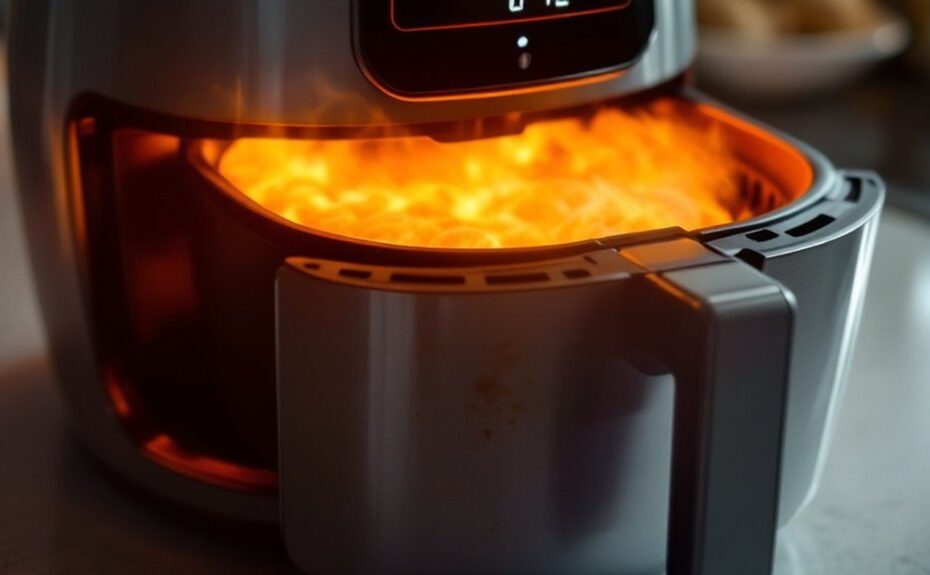If your air fryer starts emitting a burning smell, producing excessive smoke, or making unusual noises, it might be overheating. You might also notice the exterior feels hotter than usual or that your food is cooking unevenly or burning too quickly. These signs could point to a deeper issue, like blocked vents or faulty heating elements. But how do you confirm the problem and prevent it from escalating? Understanding the causes and solutions could save your appliance—and your kitchen—from potential hazards. Stay tuned to uncover the steps you can take to guarantee your air fryer operates safely and efficiently.
Key Takeaways
- Unusual odors, like burning smells, or excessive smoke during operation indicate potential overheating.
- The exterior feels excessively hot in areas not directly exposed to heat.
- Food cooks unevenly, burns faster than usual, or shows inconsistent cooking temperatures.
- Unusual noises, such as rattling or grinding, suggest mechanical stress or overheating.
- Frequent error codes (e.g., E1, E2) or prolonged cooking times signal internal overheating issues.
Signs Your Air Fryer Is Overheating
If your air fryer is overheating, you may notice unusual odors, such as a burning smell, or excessive smoke during operation. These signs often indicate that internal components, like the heating element or fan, are struggling to function properly. You might also hear unusual noises, such as rattling or grinding, which suggest mechanical stress or obstruction. The appliance's exterior may feel excessively hot to the touch, even in areas not directly exposed to heat. Additionally, food may cook unevenly or burn faster than usual, signaling inconsistent temperature regulation. If the air fryer's safety mechanisms activate, it could automatically shut off to prevent further damage. Monitoring these symptoms helps you identify overheating early, reducing the risk of permanent damage or safety hazards. Always unplug the unit if you suspect overheating.
Common Causes of Air Fryer Overheating
Your air fryer may overheat due to faulty thermostat settings, which disrupt temperature regulation. Blocked air vents can restrict airflow, causing heat buildup and improper circulation. Overloading the cooking basket reduces space for air movement, leading to uneven heating and potential overheating.
Faulty Thermostat Settings
When the thermostat in your air fryer malfunctions, it can lead to inaccurate temperature regulation, causing the appliance to overheat. A faulty thermostat may fail to maintain temperature accuracy, resulting in the heating element operating at higher-than-intended levels. This issue often stems from improper thermostat calibration, where the internal sensor misreads the actual cooking temperature. Over time, wear or electrical faults can degrade the thermostat's performance, causing it to cycle incorrectly or remain stuck in a high-heat state. To diagnose, monitor if your air fryer consistently exceeds the set temperature or shuts off prematurely. Use an external thermometer to verify temperature accuracy during operation. If discrepancies persist, recalibrate or replace the thermostat to restore proper functionality and prevent overheating risks.
Blocked Air Vents
Blocked air vents are another frequent cause of air fryer overheating, disrupting the appliance's ability to circulate hot air effectively. When vent blockage occurs, airflow restriction prevents proper heat distribution, causing the internal temperature to rise excessively. Check the intake and exhaust vents for obstructions like food debris, grease buildup, or improper placement near walls. A clogged vent forces the heating element to work harder, increasing the risk of overheating. Use a soft brush or damp cloth to clean the vents regularly, ensuring unobstructed airflow. If the air fryer continues to overheat after clearing the vents, inspect for deeper blockages in the internal fan or heating chamber. Proper maintenance prevents airflow restriction, ensuring efficient operation and reducing overheating risks.
Overloaded Cooking Basket
Overloading the cooking basket, though tempting to save time, can lead to overheating by disrupting the air fryer's ability to circulate hot air evenly. Exceeding the basket capacity restricts airflow, causing the heating element to work harder to maintain temperature. Uneven food distribution compounds this issue, creating hot spots and forcing the appliance to overcompensate. Check your air fryer's manual for the recommended basket capacity and avoid stacking or overcrowding ingredients. Spread food in a single layer, guaranteeing sufficient space between items for ideal air circulation. Overloading not only risks overheating but also compromises cooking performance, resulting in unevenly cooked food. Monitor the appliance for signs of strain, such as excessive noise or prolonged cooking times, which indicate the basket is overloaded. Adhering to capacity guidelines secures efficient operation and prevents overheating.
How to Check for Overheating Issues
Monitor the air fryer's internal temperature using an infrared thermometer to verify it aligns with the set cooking parameters. Check the display panel for error codes, such as E1 or E2, which often indicate overheating or sensor malfunctions. Inspect the heating element and fan for obstructions or irregularities that could disrupt proper heat distribution.
Monitor Temperature Levels
To determine if your air fryer is overheating, you'll need to assess its temperature levels during operation. Start by verifying the accuracy of its temperature sensors, which regulate internal heat. Use an external infrared thermometer to measure the air fryer's internal temperature during a cooking cycle. Compare this reading to the set temperature on the control panel. Significant discrepancies may indicate faulty sensors or uneven heat distribution. Observe if certain areas of the basket or food cook faster than others, as this suggests inconsistent heat distribution. Additionally, listen for unusual noises, such as excessive fan whirring, which could signal the unit is struggling to maintain stable temperatures. Consistently high readings or erratic fluctuations are clear indicators of overheating.
Inspect for Error Codes
If your air fryer's temperature readings appear inconsistent or it exhibits unusual behavior, checking for error codes can help identify overheating issues. Most modern air fryers display error codes on their digital screens when a malfunction occurs. Refer to your user manual to decode the specific error code meanings, as they vary by model. Common overheating-related codes include "E1" or "ERR" followed by numbers, indicating temperature sensor failures or excessive heat. To resolve these, unplug the unit, let it cool, and inspect for blockages in the heating element or fan. If the issue persists, consult the manufacturer's error code solutions or contact customer support. Regularly monitoring these codes guarantees timely troubleshooting and prevents prolonged overheating risks.
Safety Risks of an Overheating Air Fryer
When an air fryer overheats, it can pose significant safety hazards, including the risk of fire, electrical malfunctions, or damage to the appliance itself. Fire hazards arise when excessive heat causes internal components to ignite or when oil or food debris accumulates and combusts. Electrical malfunctions, such as short circuits or blown fuses, may occur if the overheating damages wiring or overloads the circuit. Prolonged overheating can also degrade the heating element, fan motor, or control panel, compromising the air fryer's functionality. Additionally, overheating may lead to thermal runaway, where the appliance fails to regulate its temperature, increasing the risk of burns or structural damage. Always monitor your air fryer for unusual heat levels or odors, as these are early indicators of potential safety risks.
Steps to Cool Down an Overheating Air Fryer
While an overheating air fryer can be alarming, taking immediate action can prevent further damage or safety risks. First, unplug the appliance to cut power and halt heat generation. Allow the air fryer to cool naturally; avoid placing it in water or using external cooling methods like fans, as rapid temperature changes may harm internal components. Check the air vents for blockages, ensuring proper airflow for temperature control. If the unit has a removable basket, take it out to reduce heat retention. Monitor the exterior temperature, ensuring it drops to a safe level before inspecting further. Avoid restarting the air fryer until you've identified and resolved the overheating cause. These steps prioritize safety and prevent exacerbating the issue.
Maintenance Tips to Prevent Overheating
To prevent your air fryer from overheating, regular maintenance is essential to secure peak performance and safety. Perform regular cleaning after each use to remove food debris and grease buildup, which can obstruct airflow and cause overheating. Use a soft brush or cloth to clean the heating element and fan, making certain no residue remains. Inspect the air fryer basket and tray for blockages, as these can disrupt proper ventilation. Proper storage is equally critical; store the unit in a cool, dry place, away from heat sources, and confirm it's unplugged when not in use. Avoid stacking items on top of the air fryer to prevent damage to its components. By adhering to these practices, you'll minimize overheating risks and extend the appliance's lifespan.
When to Replace Your Air Fryer
Even with proper maintenance, air fryers have a finite lifespan and may eventually require replacement. Monitor your appliance for signs of performance decline, such as inconsistent cooking temperatures, prolonged cooking times, or unevenly cooked food. These issues often indicate wear on internal components like heating elements or fans. If your air fryer's warranty expiration has passed and repairs exceed the cost of a new unit, replacement becomes a practical choice. Additionally, frequent overheating episodes or error codes that persist despite troubleshooting suggest irreparable damage. Evaluate the appliance's age and usage frequency; most air fryers last 3-5 years with regular use. When repairs are no longer cost-effective or performance deteriorates substantially, upgrading to a newer model guarantees peak functionality and safety.
Troubleshooting Overheating Problems
If your air fryer is overheating, it's likely due to a malfunction in its internal components or improper usage. Start by checking for power surges, which can damage the heating element or thermostat. Inspect the power cord and outlet for signs of electrical faults, such as fraying or scorch marks. Make sure the air fryer isn't placed near heat sources or obstructing vents, as this can disrupt airflow and cause overheating. Test the temperature sensor by running the appliance empty; if it shuts off prematurely or fails to regulate heat, the sensor may be faulty. Examine the fan for debris or blockages, as restricted airflow can lead to excessive heat buildup. If issues persist, consult the manufacturer's troubleshooting guide or seek professional repair.
Best Practices for Air Fryer Use
Proper air fryer use guarantees peak performance and prevents issues like overheating. Always preheat the unit for 2-3 minutes to achieve consistent cooking temperatures. Follow the manufacturer's guidelines for ideal cooking times, as exceeding them can strain the heating element. Avoid overcrowding the basket to maintain proper airflow, which prevents uneven cooking and overheating. Use proper cleaning techniques after each use, removing food debris and grease from the basket, tray, and interior to prevent buildup that can obstruct ventilation. Regularly inspect the air fryer's heating coil and fan for obstructions or damage. Make sure the appliance is placed on a heat-resistant, flat surface with adequate clearance for ventilation. Monitor cooking progress to avoid prolonged operation at high temperatures, which can trigger overheating.
Disclosure: As an Amazon Associate, I earn from qualifying purchases.



